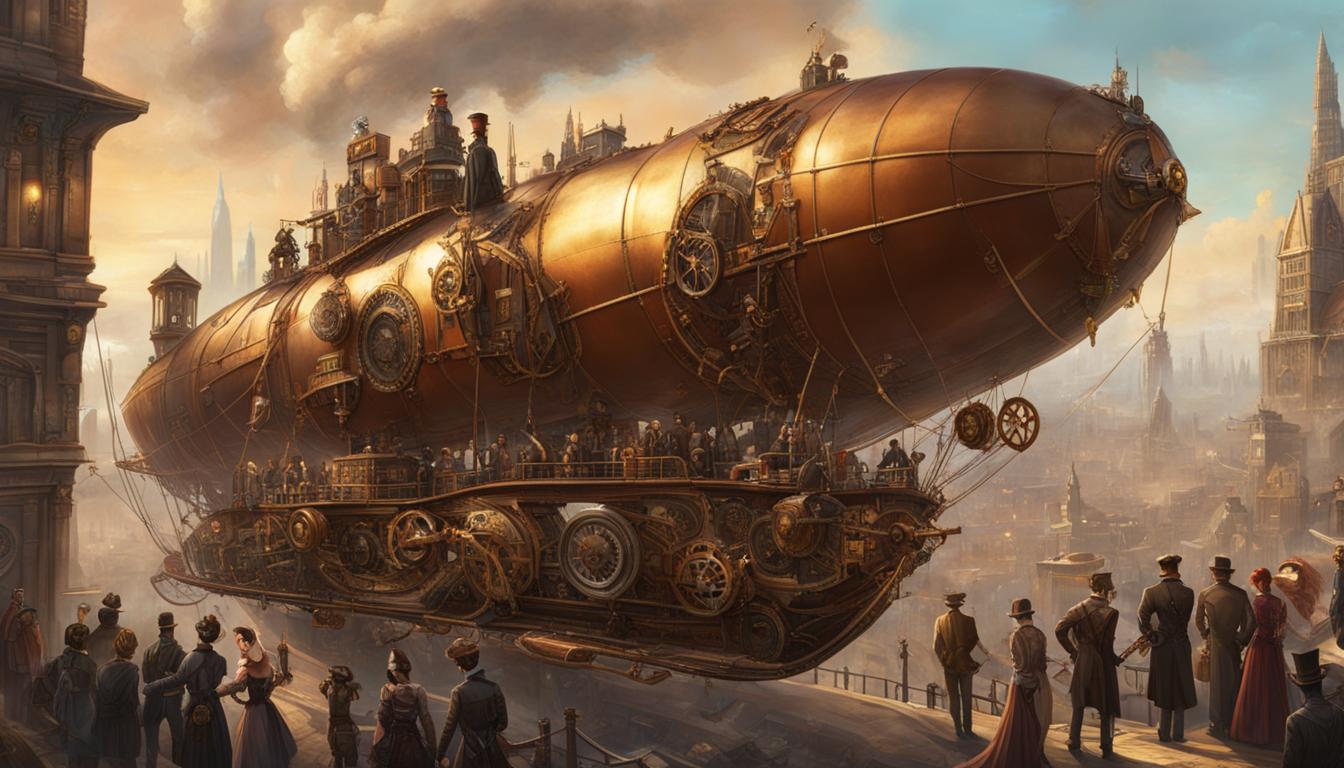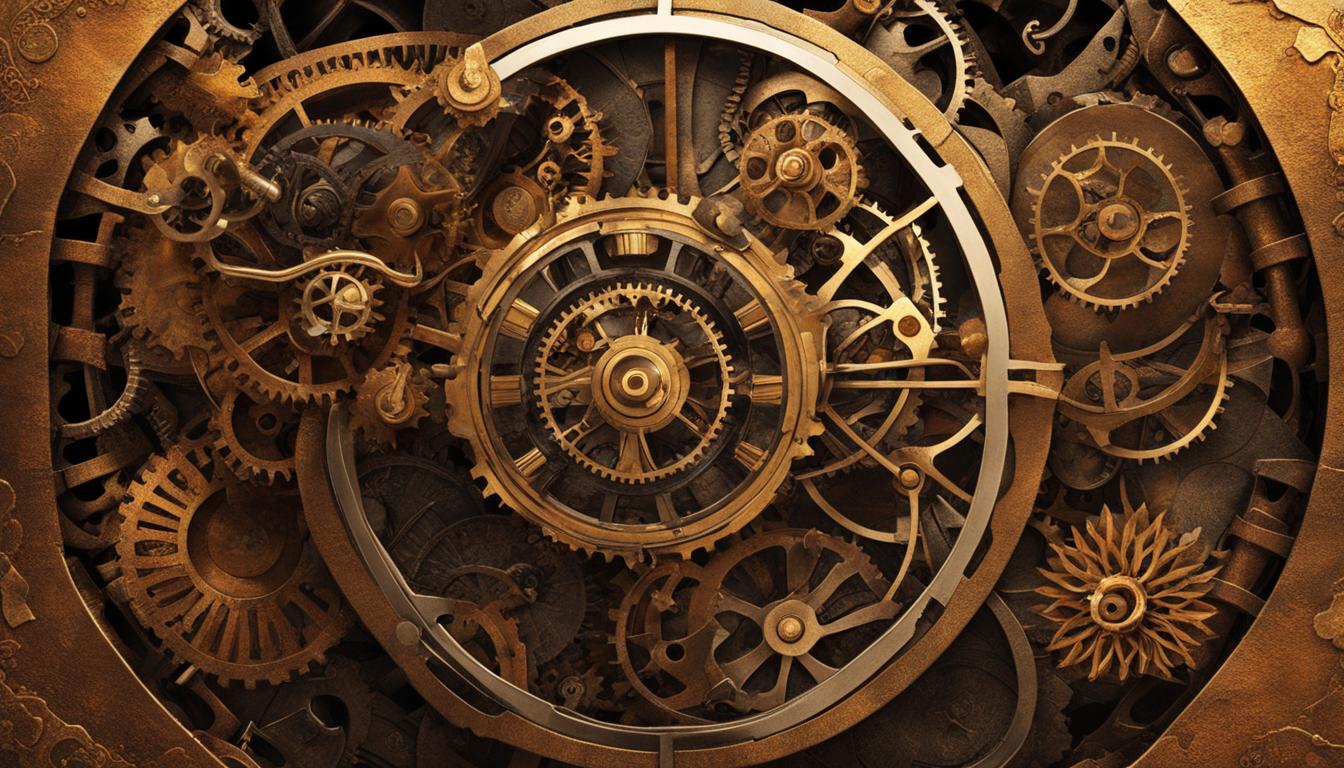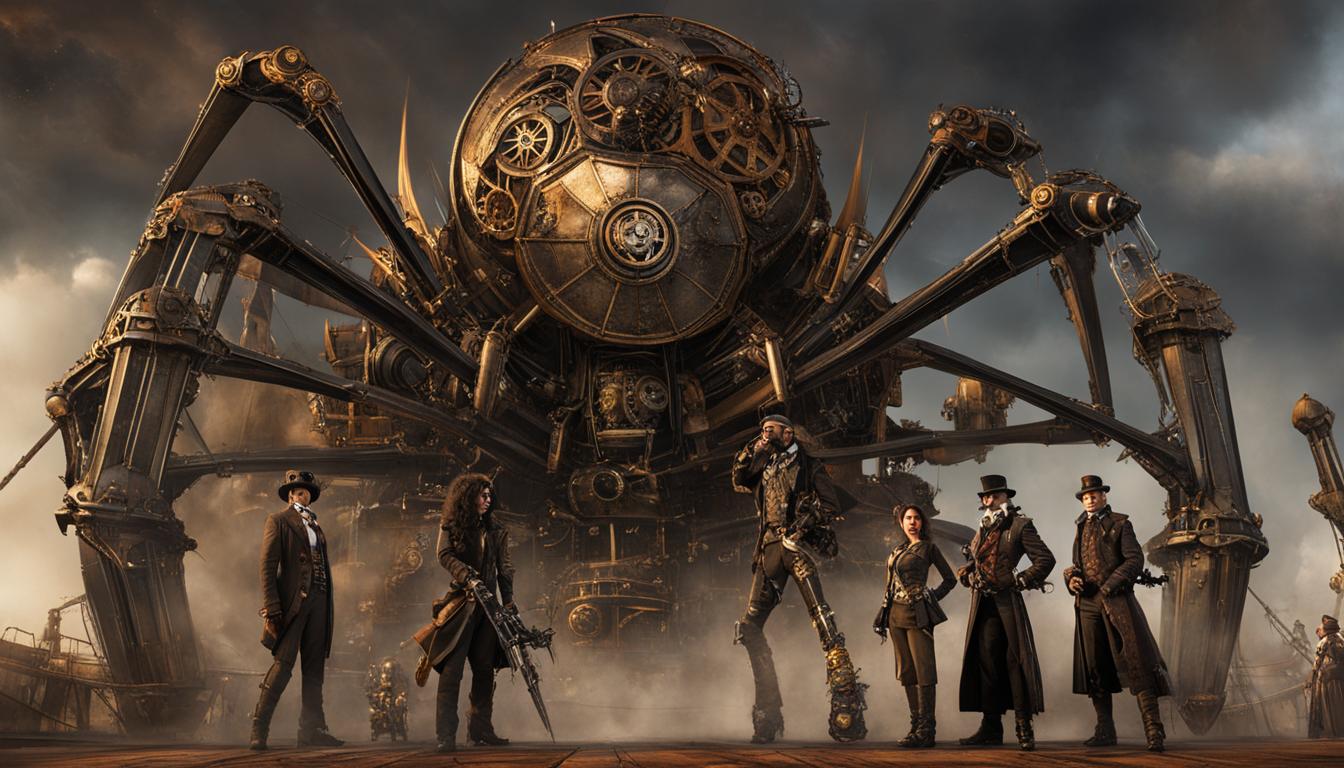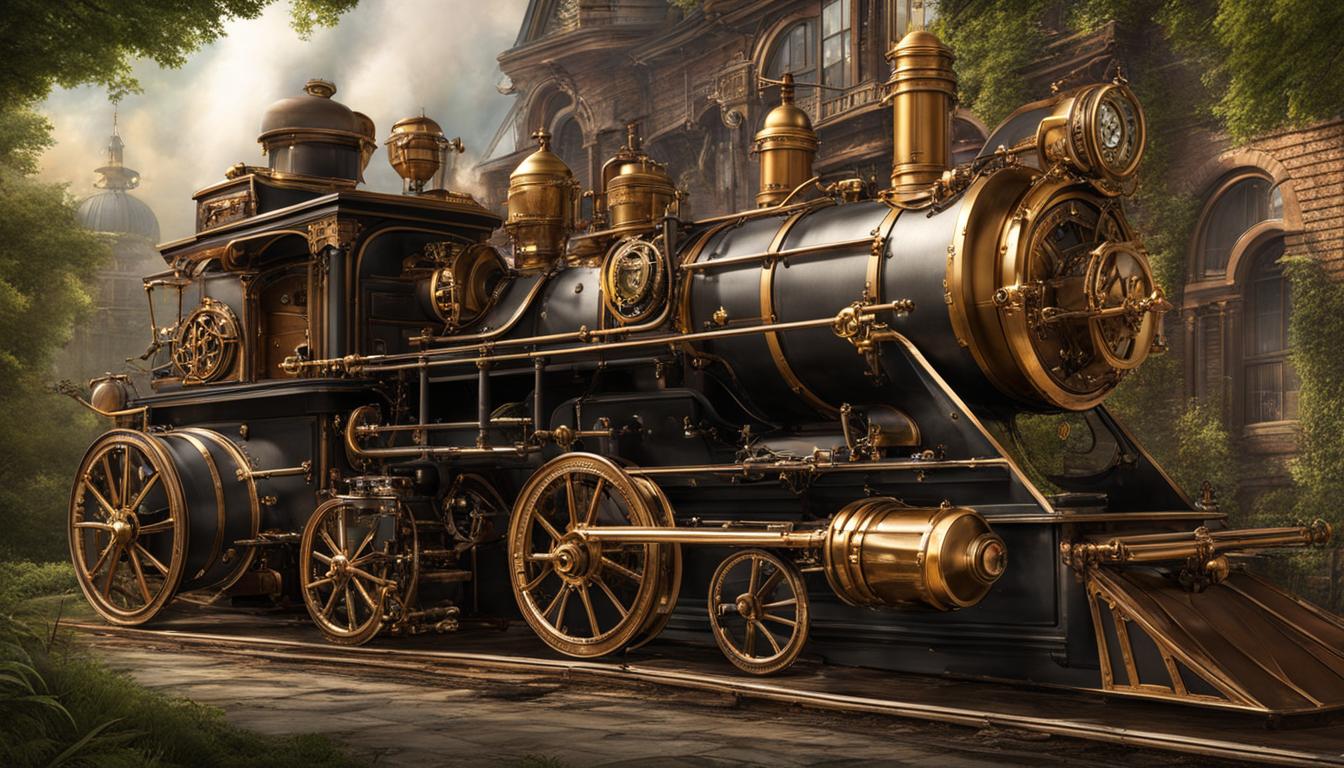Steampunk, a captivating cultural movement rooted in science fiction and fantasy literature, has emerged as a powerful force in recent years. With its nostalgic inspiration drawn from the Victorian era and the Industrial Revolution, steampunk has left an indelible mark on historical narratives and reimagined the way we perceive history.
Steampunk’s historical significance lies in its ability to transport us to a bygone era while infusing it with a sense of futuristic wonder. It seamlessly blends retrofuturistic technology, intricate aesthetics, and a hint of mystery, captivating the imaginations of enthusiasts worldwide.
By examining the impact of steampunk on history, we uncover how this cultural phenomenon has reshaped our understanding of the past and the present. Let’s delve into the historical origins and influences of steampunk, explore key figures in the movement, and discover its far-reaching influence in literature, visual media, and fashion.
Key Takeaways:
- Steampunk revolutionizes historical narratives by offering a unique perspective that combines the past with an imaginative future.
- Victorian era aesthetics and the Industrial Revolution heavily influence the steampunk movement, shaping its distinctive visual style.
- Pioneers of science fiction like Jules Verne and H.G. Wells have played a crucial role in the development and popularization of steampunk.
- Steampunk has expanded beyond literature to encompass visual media, with films and television shows incorporating its captivating elements.
- Steampunk fashion showcases the fusion of vintage Victorian style with futuristic technology, creating an iconic and recognizable aesthetic.
The Influence of the Victorian Era on Steampunk
The Victorian era, lasting from 1837 to 1901, played a crucial role in shaping the steampunk movement. This remarkable period in history witnessed significant social and economic transformations, including the rise of the British Empire and the dawn of the Industrial Revolution. Steampunk incorporates many aspects of the Victorian era, reflecting its influence on the movement’s aesthetics, themes, and narratives.
One of the key elements of the steampunk genre is its portrayal of the strict social hierarchy and class divide prevalent during the Victorian era. The movement often explores the tensions and disparities between the upper and working classes, adding depth and historical context to its narratives. The attention to detail and the ornate designs of the Victorian era are also prominent features of the steampunk aesthetic, creating a visual feast for enthusiasts and helping transport them to an alternate reality where steam-powered inventions and retrofuturistic technology dominate.
Steampunk’s fascination with the Victorian era extends beyond its aesthetic influences. The Victorians were known for their relentless pursuit of progress and innovation, and the Industrial Revolution was a pivotal period of change. Steampunk embraces this fascination by incorporating steam-powered machines, factories, and advanced technology as an integral part of its storytelling. By delving into the historical context of the Industrial Revolution, the movement adds an immersive layer to its narratives, emphasizing the transformative power of technological advancements during this era.
Overall, the Victorian era’s impact on steampunk cannot be overstated. Its societal structures, aesthetic beauty, and technological advancements have all left an indelible mark on the movement, making it a relevant and captivating genre in contemporary culture. Steampunk’s fusion of history, fantasy, and science fiction provides a unique lens through which to explore the past and reimagine the future, ensuring its enduring importance in both the literary and cultural realms.
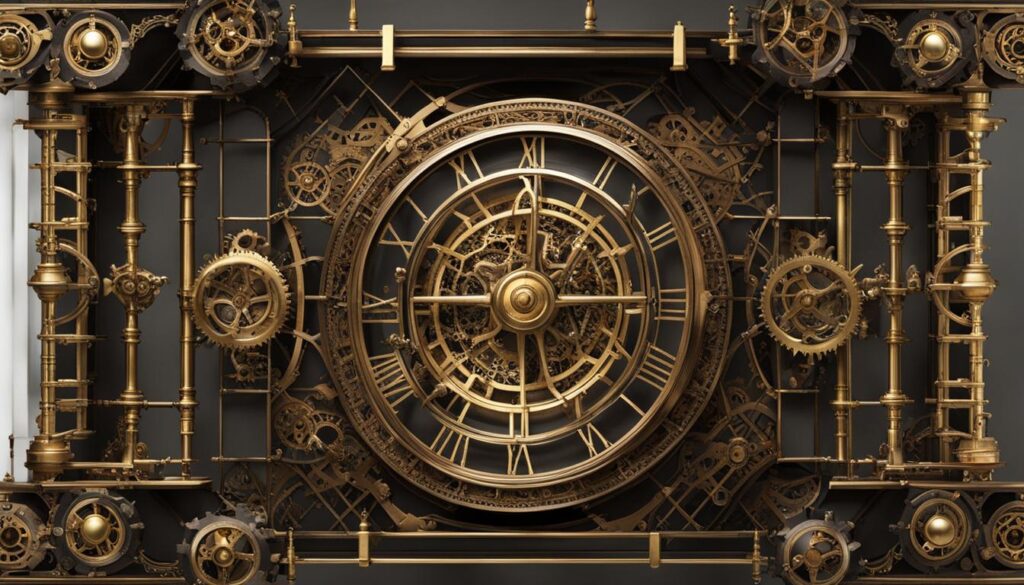
Key Influences of the Victorian Era on Steampunk:
- The Victorian social hierarchy and class divide
- The attention to detail and ornate designs
- The transformative power of the Industrial Revolution
- The pursuit of progress and innovation
Notable Works Showcasing the Victorian Influence:
- “The Difference Engine” by William Gibson and Bruce Sterling
- “Perdido Street Station” by China Miéville
- “The Strange Affair of Spring Heeled Jack” by Mark Hodder
- “Boneshaker” by Cherie Priest
The Impact of the Industrial Revolution on Steampunk
The Industrial Revolution, with its invention of steam-powered machinery, had a profound impact on the steampunk movement. It revolutionized the way goods were produced and led to the rapid industrialization of Britain. Steampunk incorporates steam-powered machines, factories, and advanced technology as a central theme, reflecting the influence of the Industrial Revolution on the movement. The emphasis on steam power and machinery in steampunk highlights the historical significance of this time period.
Steampunk draws inspiration from the transformative changes brought about by the Industrial Revolution. The movement romanticizes the era when steam power drove innovation and propelled society forward. It encapsulates the spirit of progress, invention, and exploration that characterized the Industrial Revolution, while also incorporating elements of fantasy and imagination.
In steampunk literature and visual media, the Industrial Revolution is often depicted through the intricate design and functionality of steam-powered contraptions. The gears, pipes, and steam-powered engines showcased in steampunk artwork and costumes pay homage to the technological advancements of the time. Through its incorporation of these elements, steampunk allows individuals to revisit and re-imagine the historical relevance of the Industrial Revolution.
Table: Steampunk Technology vs. Industrial Revolution Technologies
| Steampunk Technology | Industrial Revolution Technology |
|---|---|
| Steam-powered airships | Steam-powered locomotives |
| Pneumatic tubes for communication | Telegraph system |
| Brass and copper gears | Factory machinery |
| Victorian-style gear-driven computers | First mechanical computers |
The table above showcases some of the key differences between the technologies found in steampunk and those developed during the Industrial Revolution. While steampunk often incorporates fantastical and exaggerated versions of these technologies, the table highlights the similarities and nods to the advancements made during the period.
Overall, the Industrial Revolution serves as a foundational element of the steampunk movement. By paying homage to the innovations and progress of the time, steampunk invites individuals to explore and reimagine the historical relevance of the Industrial Revolution, bridging the gap between history and fantasy.
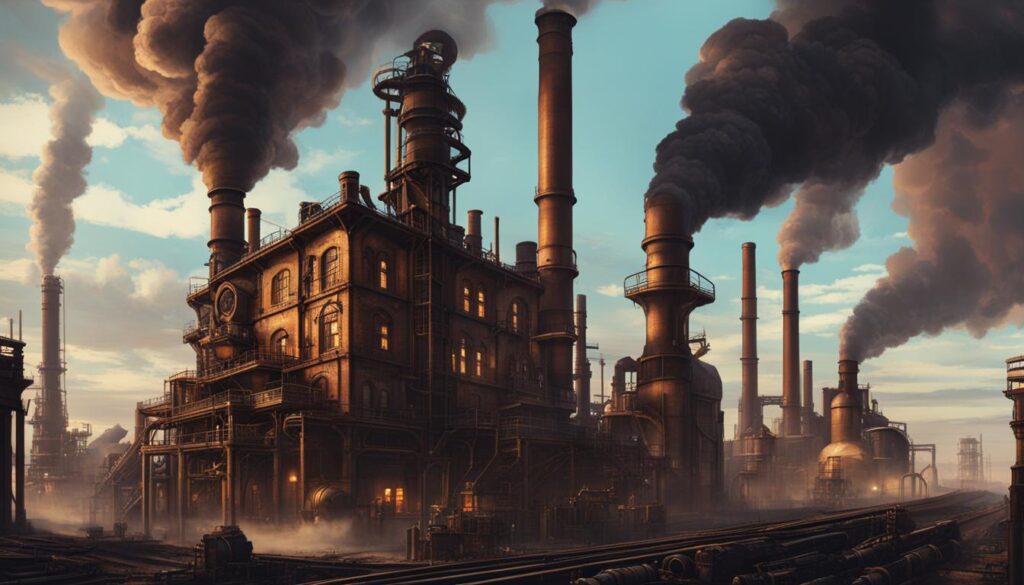
Key Figures in the Steampunk Movement
The steampunk movement has been shaped by influential figures in literature, film, and music. These individuals have left their mark on history by contributing to the development and popularization of steampunk as a cultural phenomenon.
The Fathers of Steampunk: Jules Verne and H.G. Wells
“The sequel follows…
Jules Verne and H.G. Wells are considered the fathers of the steampunk genre. They were pioneers of science fiction, envisioning worlds filled with fantastical machinery and technologies. Verne’s works, such as “20,000 Leagues Under the Sea,” and Wells’ classics like “The Time Machine” and “The War of the Worlds,” laid the foundation for the steampunk aesthetic and themes.
These authors not only influenced the development of steampunk but also contributed to the greater realm of science fiction. Their imaginative storytelling and exploration of the possibilities of technology have had a lasting impact on literature and popular culture.
Steampunk Authors: William Gibson, K.W. Jeter, and Bruce Sterling
“The sequel follows…
William Gibson, K.W. Jeter, and Bruce Sterling are among the authors who played a key role in the popularization of steampunk in the late 20th century. Gibson’s novel “The Difference Engine,” co-written with Bruce Sterling, is often regarded as the work that brought steampunk into the mainstream.
K.W. Jeter introduced the term “steampunk” in his letter to Locus magazine in 1987, describing a genre that combines Victorian aesthetics with modern technology. Jeter’s novels, such as “Infernal Devices” and “Fiendish Schemes,” have expanded the steampunk canon, exploring alternative histories and imaginative worlds.
Bruce Sterling, a co-founder of the cyberpunk movement, also contributed to the steampunk genre with his novel “The Difference Engine” and his short story collection “The Difference Engine: Tales of the New Steampunk Order.” His works have embraced the fusion of Victorian sensibilities with futuristic elements.
Steampunk in Film and Music
“The sequel follows…
Steampunk has also made its mark on the world of cinema and music. Films such as “The League of Extraordinary Gentlemen,” based on the graphic novel by Alan Moore and Kevin O’Neill, and “Wild Wild West,” starring Will Smith, have incorporated steampunk elements into their storytelling and visual design.
In the realm of music, bands like Abney Park have embraced the steampunk aesthetic and infused it into their songs and performances. Abney Park’s music combines elements of industrial, rock, and world music, capturing the essence of a steampunk-inspired world in their sound.
These key figures in the steampunk movement have contributed to its importance in culture and its mark on history. From visionary authors to innovative filmmakers and musicians, they have fueled the imagination of countless individuals and helped solidify steampunk as a unique and enduring movement.
| Key Figures | Contributions |
|---|---|
| Jules Verne and H.G. Wells | Founders of steampunk genre; pioneers of science fiction |
| William Gibson | Popularized steampunk with “The Difference Engine” |
| K.W. Jeter | Coined the term “steampunk”; expanded the genre with his novels |
| Bruce Sterling | Co-founder of cyberpunk; contributed to steampunk literature |
| “The League of Extraordinary Gentlemen” (Film) | Incorporated steampunk elements into storytelling and design |
| Abney Park (Music) | Infused steampunk aesthetic into their music and performances |
These figures, both past and present, have shaped the course of steampunk, leaving a lasting contribution to its cultural significance and historical impact.
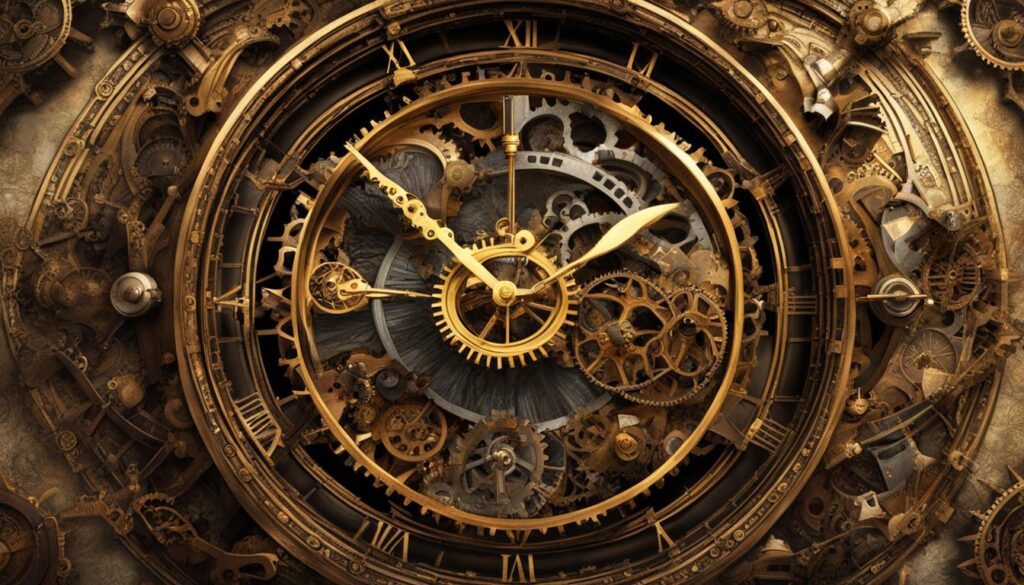
Steampunk in Literature and Visual Media
Steampunk has made a significant impact on history through its presence in literature and visual media. The movement’s influence on these mediums is evident in both classic works and contemporary masterpieces. Authors like Jules Verne and H.G. Wells, considered the fathers of science fiction, laid the groundwork for the steampunk genre. Their imaginative stories, such as Verne’s “20,000 Leagues Under the Sea” and Wells’ “The Time Machine,” introduced readers to a world where steam-powered technology and Victorian aesthetics merged.
Contemporary steampunk literature continues to shape the genre and its impact on history. Authors like Tim Powers and Scott Westerfeld have contributed to the steampunk movement with their thought-provoking novels. Powers’ “The Anubis Gates” combines time travel, ancient Egyptian mythology, and Victorian London, while Westerfeld’s “Leviathan” series reimagines World War I through a steampunk lens. These literary works not only entertain but also offer a fresh perspective on historical narratives, showcasing the historical relevance of steampunk.
In visual media, steampunk has found a home in films and television shows. Movies like “Wild Wild West” and “Sherlock Holmes” incorporate steampunk elements, blending historical settings with futuristic technology. These visual representations of steampunk provide a unique and captivating experience, showcasing its impact on historical narratives and visual storytelling. The intricate costumes, elaborate sets, and imaginative gadgets transport audiences to a world where the Victorian era collides with imaginative possibilities.
Overall, steampunk’s presence in literature and visual media highlights its place in historical narratives and its impact on history. From classic works to contemporary masterpieces, the genre continues to shape the way we view and appreciate history. Whether through the pages of a novel or on the big screen, steampunk invites us to reimagine the past and explore the endless possibilities of a retrofuturistic world.
Table: Comparing Steampunk Books and Films
| Steampunk Literature | Steampunk Films |
|---|---|
| Tim Powers’ “The Anubis Gates” | “Wild Wild West” |
| Scott Westerfeld’s “Leviathan” series | “Sherlock Holmes” |
| Jules Verne’s “20,000 Leagues Under the Sea” | – |
| H.G. Wells’ “The Time Machine” | – |
Steampunk Aesthetic and Fashion
The steampunk movement is not just confined to literature and visual media; it has also made a significant impact on the world of fashion. Steampunk fashion draws inspiration from the Victorian era, blending vintage style with futuristic elements to create a unique and captivating look. Intricate designs, corsets, and gears are key features of this distinctive aesthetic.
Steampunk fashion embraces both functionality and style, with clothing that is often adorned with gears, buckles, and intricate detailing. The use of corsets and waistcoats adds a touch of elegance, while accessories like goggles and pocket watches complete the ensemble. The blending of historical and futuristic elements creates a captivating visual that has captured the imagination of many.
Steampunk fashion extends beyond clothing to include accessories, gadgets, and even home decor. For those who embrace the steampunk lifestyle, every aspect of their lives becomes an opportunity to showcase this distinctive aesthetic. From the gadgets they carry to the furnishings in their homes, steampunk enthusiasts live in a world that is both historically grounded and imaginatively futuristic.
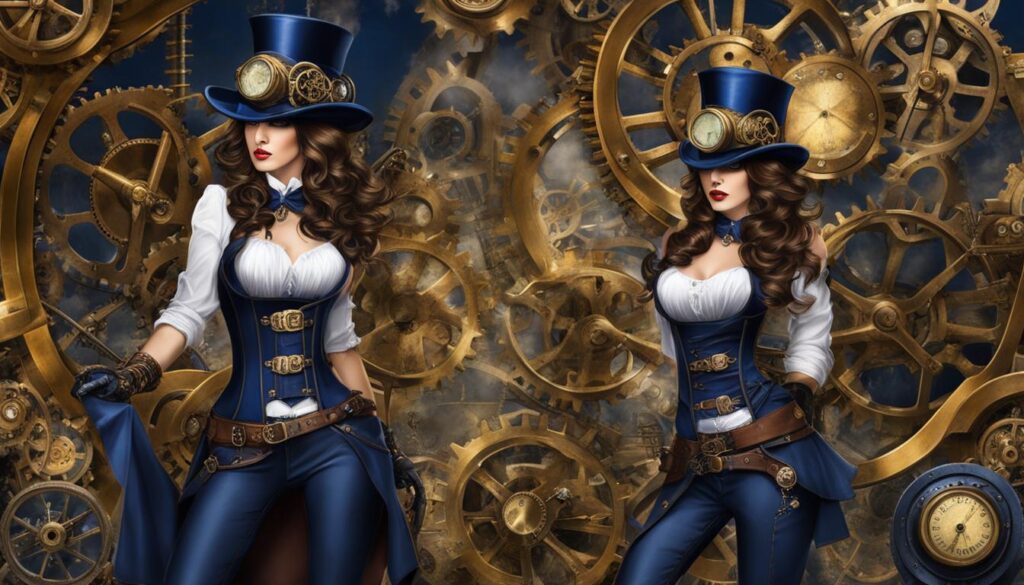
Steampunk’s historical place in fashion cannot be ignored. It has not only influenced the way we dress and accessorize, but it has also become an integral part of our cultural identity. The combination of Victorian elegance and futuristic technology has captured the attention and admiration of many, making steampunk an enduring and beloved fashion trend.
Conclusion
The legacy of steampunk is firmly imprinted on history, marking its presence with a unique blend of creativity and imagination. By drawing inspiration from the Victorian era and the Industrial Revolution, steampunk has given rise to a cultural movement that has left an indelible mark on various aspects of society.
Through literature, visual media, fashion, and even technology, steampunk has reshaped our understanding of history. It offers a fresh perspective, inviting us to reinterpret and reimagine historical narratives in ways that are both captivating and thought-provoking. The steampunk movement has breathed new life into the past, offering a glimpse into a retrofuturistic world where steam-powered machinery and ornate designs reign supreme.
The contribution of steampunk to history cannot be understated. It has sparked a resurgence of interest in the Victorian era and the Industrial Revolution, reminding us of the social, economic, and technological advancements that shaped those times. Steampunk’s unique aesthetic and fashion have also become symbols of its cultural impact, bridging the gap between the past and the future in a visually striking way.
Steampunk’s mark on history is one that will continue to be felt for years to come. Its legacy lies in its ability to transport us to a fantastical world where imagination knows no bounds. By embracing the past while infusing it with futuristic elements, steampunk has given us a new lens through which to view and appreciate history, leaving us captivated and inspired.
FAQ
What is steampunk?
Steampunk is a cultural movement that draws inspiration from the Victorian era and the Industrial Revolution. It incorporates retrofuturistic technology and aesthetics, creating a unique blend of history and fantasy.
How has the Victorian era influenced steampunk?
The Victorian era, with its social hierarchy and ornate designs, heavily influences the steampunk movement. It reflects the strict social structure and attention to detail of the Victorian era in its aesthetic and storytelling.
What impact did the Industrial Revolution have on steampunk?
The Industrial Revolution, with its steam-powered machinery and rapid industrialization, has had a profound impact on steampunk. Steam-powered machines, factories, and advanced technology are central themes in the movement, highlighting the historical significance of this time period.
Who are key figures in the steampunk movement?
Pioneers of science fiction like Jules Verne and H.G. Wells are considered the fathers of steampunk and have influenced the movement. Authors like William Gibson, K.W. Jeter, and Bruce Sterling have also played a significant role in popularizing the steampunk aesthetic through their novels.
How has steampunk influenced literature and visual media?
Steampunk has had a significant impact on literature and visual media. It has reimagined historical narratives and introduced retrofuturistic elements into storytelling. Films like “Wild Wild West” and television shows like the BBC’s “Sherlock Holmes” series have incorporated steampunk elements, showcasing its influence on culture.
What is the steampunk aesthetic and fashion?
Steampunk fashion draws inspiration from the Victorian era, with intricate designs, corsets, and gears as key elements. It fuses vintage style with futuristic technology, showcasing the historical place of steampunk in fashion and culture.
What is the historical significance of steampunk?
Steampunk has had a transformative influence on culture and history. By drawing inspiration from the Victorian era and the Industrial Revolution, it has reinterpreted and reimaged historical narratives. Steampunk’s impact can be seen in literature, visual media, fashion, and even technology, leaving a lasting legacy on how we understand and appreciate history.


